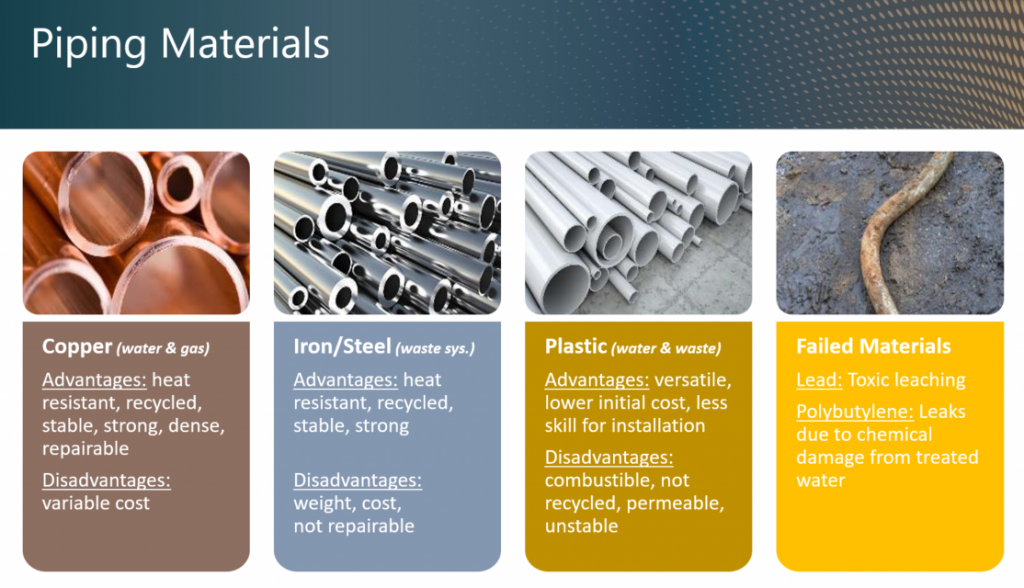Sustainability Characteristics of Piping Materials
Highlights from BSS Industry Conference – Part 1
 Contractors, engineers, and manufacturers raised great questions and discussions after our presentation to the invite-only BSS Conference at Wembley Stadium in London. We focused on two important issues that don’t always get the focus they deserve. First, how different pipe materials stack up on sustainability. Second, the effects of pipe materials on fire safety in buildings.
Contractors, engineers, and manufacturers raised great questions and discussions after our presentation to the invite-only BSS Conference at Wembley Stadium in London. We focused on two important issues that don’t always get the focus they deserve. First, how different pipe materials stack up on sustainability. Second, the effects of pipe materials on fire safety in buildings.
We discussed these important issues in the Q&A:
- How do we better inform the construction industry about safety and sustainability issues related to piping?
- What should pipe manufacturers be doing to improve the sustainability of their products and the systems they support?
- Where can we learn more about the effects of piping materials on fire safety?
- How common are firestopping problems in buildings that are already constructed and in use?
Before we answer the first two questions, we’ll recap key points on sustainability. For a summary of fire safety issues and questions, see part 2.
Piping & Plumbing Systems
The main materials covered by our analysis included:
- Copper pipe, which is used mainly for water and gas systems;
- Pipes made of iron and steel in gas and drain-waste-vent systems; and
- Plastic pipes – CPVC, PVC, HDPE, and PEX – used in various applications throughout buildings.
Each pipe material has strengths and weaknesses as the chart shows, including different levels of strength, resilience, and performance.
For comparison, we also looked at pipes made of lead and pipes made of polybutylene plastic. These failed materials can teach us important lessons about what happens when failed piping puts the health and safety of buildings at risk.

Piping Sustainability
From a sustainability standpoint, we considered the lifecycles of each material type: from production, through use, and in the disposal phase.
The Lifecycle of Metal Pipes
Copper, iron, and steel have similar characteristics. At the production stage, mining and refining metal ore has environmental impacts and generates a carbon footprint. Both industries have acknowledged these challenges and worked hard to address them by engineering processes to incorporate significant recycled content and minimize emissions. In use, both are structurally strong and have long service life. And after use, both are fully recyclable and maintain high financial and performance value.
The Lifecycle of Plastic Pipes
Plastic shares some of the production challenges of metal production. Plastic comes from fossil fuels, using oil and natural gas to generate the pellets that become feedstock for manufacturing pipes and other products. In use, the many types of plastic make it more difficult to ensure they are installed and maintained according to manufacturer requirements. But the most significant difference of plastic pipes comes at the end of product life. The materials aren’t engineered for recycling so it’s not surprising that all plastic pipe becomes waste after it’s used. They either get sent to landfills or are burned in trash incinerators. Plastic pipes are not reused and they have no residual value. (Ironically, the plastics industry spins the as a benefit, saying plastic pipes have “No scrap value, avoiding jobsite theft.” Thieves won’t steal them because it’s not worth it.)
It’s clear that making any kind of pipe has an impact. How they stack up in the disposal phase is the real area of difference:
- Materials like copper, iron, and steel can and are being recycled at a high rate, fueling the circular processes.
- Materials made by the plastics industry continue a linear, extract-and-dispose method.
Now let’s look at the answers to a couple of those questions.
How do we educate the construction industry about safety and sustainability issues related to piping?
This is a hard one for sustainability, because manufacturers are incentivized only to tell the green part of their story. It will take concerted effort from building owners, government leaders, or other groups to force the change to circular piping products. Producers will have to further reduce the impact of extraction and manufacturing in terms of environmental releases and energy consumption. They’ll obviously also need to ensure that their pipes will still perform safely and reliably during use. And then they will need to establish processes to gather and reuse materials that become the next cycle of products. The UN describes sustainability as taking steps now to ensure that future generations can live healthy and productive lives. Many have called this the essential challenge of our lifetimes.
What should pipe manufacturers be doing to improve the sustainability of their products and the systems they support?
This is a much simpler one. To keep improving, manufacturers across the plumbing and piping industry must be more transparent. They need to tell engineers, architects and contractors how they make their products. Work with them to address issues that happen on job sites and during the lifespans of buildings. And as noted above, they must invest in ways to make their products more circular. This is in contrast to focusing on proprietary formulations, opaque sourcing, and greenwashing. In short, asking the industry to help you stay accountable is the best way to get better.
Thank you once again to all the attendees, to the BSS organization, and to our great partners at CuSP who supported us at this event. Their work to inform the construction and building industry helps make buildings safer and more sustainable across the UK.
